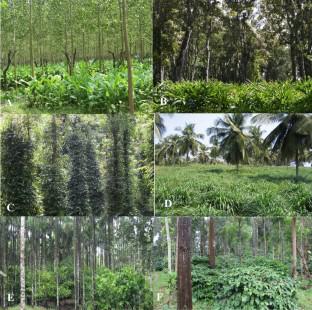Agroforestry Systems ( IF 2.2 ) Pub Date : 2024-02-09 , DOI: 10.1007/s10457-024-00957-0 B. Mohan Kumar , T. K. Kunhamu , Ankita Bhardwaj , A. V. Santhoshkumar

|
Agroforestry systems (AFS) represent combinations of trees, arable crops, and/or pastures. Being assemblages of diverse life-forms, they exhibit complex biophysical interactions. For instance, the multistrata canopies shade the understory crops by intercepting a significant amount of the incoming solar radiation. Optimizing understory productivity, thus, requires understanding the elements that affect the canopy transmittance of photosynthetically active radiation (PAR) and its spatiotemporal dynamics. We systematically reviewed the peer-reviewed literature involving 145 tropical and subtropical tree + crop combinations. The theoretical underpinnings of interspecific interactions in developing agroforestry stands were elucidated using a conceptual model. Additionally, the linkage between subcanopy PAR levels and yield was established for 11 arable crops. PAR reaching the understory and the subcanopy yield levels were tremendously variable across AFS. Relative yields ranged from 6 to 188% of the sole crops. Stage of stand development, canopy architecture, and management factors are cardinal determinants of canopy light extinction, understory PAR availability, and yield. The yield of shade-tolerant crops either increased (“over-yielding”) or remained the same as PAR levels decreased within certain limits, albeit with intraspecific variations. The tree-crop interaction effects on yield were positive, negative, or neutral. In total, 19 cases showed positive responses, 29 were neutral, and 113 were negative, with a few overlapping responses depending on the tree, crop, and management. This implies that the key to ecological intensification is component selection and management. Agroforestry, while containing the loss of, maintaining, or even increasing understory yields, thus maximizes overall (tree + crop) outputs and land equivalent ratio.
中文翻译:

亚冠层光可用性、作物产量和管理意义:热带地区遮荫种植系统的系统回顾
农林业系统 (AFS) 代表树木、耕作作物和/或牧场的组合。作为不同生命形式的组合,它们表现出复杂的生物物理相互作用。例如,多层树冠通过拦截大量入射的太阳辐射来遮蔽林下作物。因此,优化林下生产力需要了解影响光合有效辐射(PAR)冠层透射率及其时空动态的因素。我们系统地回顾了涉及 145 种热带和亚热带树木 + 作物组合的同行评审文献。使用概念模型阐明了发展农林业林种间相互作用的理论基础。此外,还建立了 11 种耕作作物冠层下 PAR 水平与产量之间的联系。在整个 AFS 中,达到林下层的 PAR 和冠层下的产量水平差异很大。相对产量为单一作物的 6% 至 188%。林分发展阶段、冠层结构和管理因素是冠层光消光、林下光有效利用率和产量的主要决定因素。耐荫作物的产量要么增加(“超产”),要么保持不变,而 PAR 水平在一定限度内下降,尽管存在种内差异。树木-作物相互作用对产量的影响有正向、负向或中性。总共有 19 例显示出阳性反应,29 例呈中性反应,113 例呈阴性反应,根据树木、作物和管理的不同,有一些重叠的反应。这意味着生态集约化的关键是构件的选择和管理。农林业在控制林下产量损失、维持甚至增加林下产量的同时,最大限度地提高了总体(树木+农作物)产出和土地当量比。



























 京公网安备 11010802027423号
京公网安备 11010802027423号